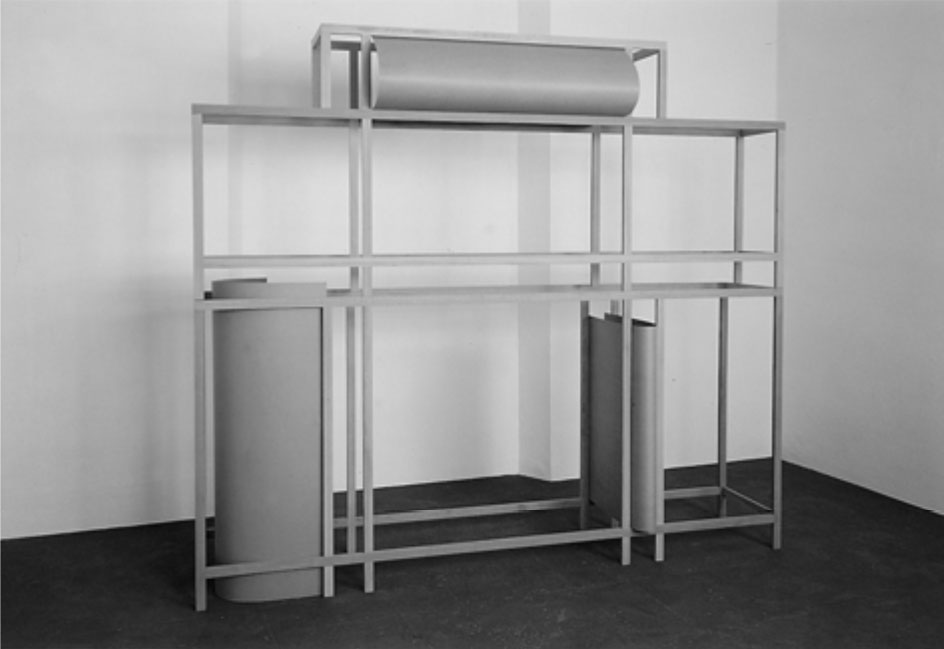IN ACCORDANCE
Elio Grazioli
Only a sculptor could reformulate the question of the picture in such a way. Antonio Catelani has already dealt with painting, and believes that, as he once so effectively summarized, “it creates itself, alone”. The hidden implication is that for Catelani, so far as painting is concerned, we are dealing with a self-creation.
Therefore, few essential elements. Sheets of paper covered with thick paint; the primary meaning of Body of Colour, the title of one of his series, is paint’s evident materiality, its thickness, or we could say relief, using a term belonging to sculpture. Few colors, but full, sharp, and strong, each sheet of paper a color, with no shading or other mani- pulations, except for the clear evidence of the material’s spreading. The painted sheets of paper were initially held together by simple hooks, springs, to give them a particular shape, perhaps that of the easel, gathered around a vase––a real one, with plants––placed on the windows and around the exhibition space, hanging freely off the wall or even gathered into an upright position. The title Articolare (“to articulate”) suggests a reading of the composition. As Catelani acutely states, this is not a problem, but a theme; in deconstructionist terms we are acting within an already codified language, an inside which includes everything and allows only swerves, shifts, switches, which asks to be occupied, inhabited.
Hence composition is relevant both within the work of art and outside it, as the piece relates to the surrounding space, to the environment, and to architecture. Once the springs are removed, everything falls apart and returns to its state of raw material, of elements available for any use, inarticulate things, sheets of paper, two-dimensional starting points, material for imagery.
When the sheets of paper are placed around potted plants, these intentions become even clearer by juxtapposition, concealed and revealed at the same time: nature, the organic, becomes the evident version of self-creation, from the inside, upsetting the mimetic relationship, and in relationship of dialogue, rather than subordination, with reality. In the same way, there is concordance between the sculpture and the plant it holds, or better, it includes; the plant is reality itself which color lays claim to, once again the body evoked in the title. But there is more to this: the plants employed are clearly house plants, plants which recall interiors and living places, stable presences which define inhabited spaces, existing and acting in the same way as Catelani’s sculptures.
Think of the earlier Tipologie, derived from the doubling of a simple perspective structure, outlining a skeleton of empty geometrical spaces (in some ways the opposite of the sheets of paper of nowadays, thus not coincidentally reproposed in a new version at the same time as the Corpo del colore series), which allowed them to stand upright, discreetely occupying a space. All the more so for today’s paintings, wall-hung: the most common interior decoration elements, in houses inhabited by man, as well as in language.
Catelani’s painting creates itself, because the sheets of paper, of different shape and color, are simply laid on the bottom of the box-shaped frame holding them. This is it––gravity to call it with its proper name: a force, a physical force, classically considered one of the foundations of sculpture. Gravitas, what gives a body weight, what gives it thought, this itself creates the composition, in a way that, I believe, no other painter has ever achieved. In this case it’s as if deconstruction required a minimum (which is still the maximum possible, not to be read as a weak position) of ontological response, of confrontation with reality, with the world: the earth on which we stand, in which the piece demands to take part fully and with equal dignity. But it does so, evidently, not by means of manifest contents adopted by the world itself, up to date representations, social themes, adapted forms, but thanks to “Madreforma” (“Mother form”) title of one of the exhibitions centered on the paintings. This term, Madreforma, condenses the reference to the mother and to the mother as form, in short to form as original reference.
But why should a sculptor choose precisely painting for this? Because a painting, more than sculpture and architecture (which had been great formal models for Catelani’s initial work), has a chief characteristic to which the artist strongly wants to draw our attention and indicate to us as mother form: frontality.

He has written: “Perhaps it is not in centrality, but in frontality, that one senses reality”; and also: “Frontality is the only possible access to reality and, once an image is doubled, immediately another one appears in a continuum which allows no pause, no location, nor, least of all, adherence to reality”. Therefore access, not adherence, because frontality is distance, it is sight as interposed space, interval, between myself and the object. Form, according to Catelani, is the answer to the presence together with the statute, rather than the state, of objects. It is the statute of art: “to mark with form its original belonging to the very world of forms”; it belongs to world since its origin, and the world itself is a world of forms. The extent to which we currently need, still, for these kind of issues to be defined, and in this manner––in works of art––is a valid subject for further reflection and this is precisely Antonio Catelani’s contribution.